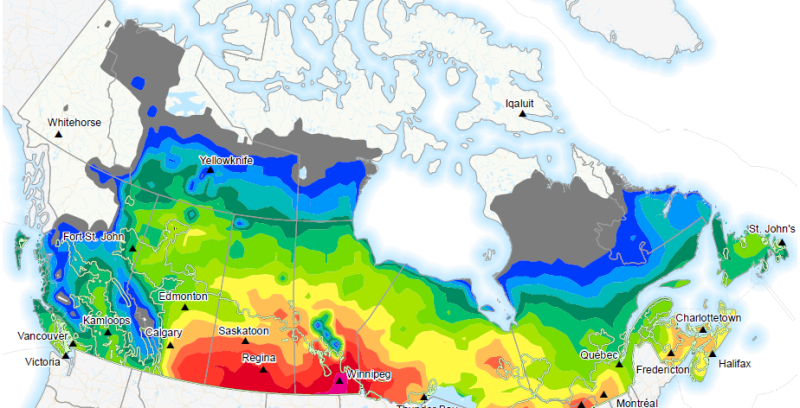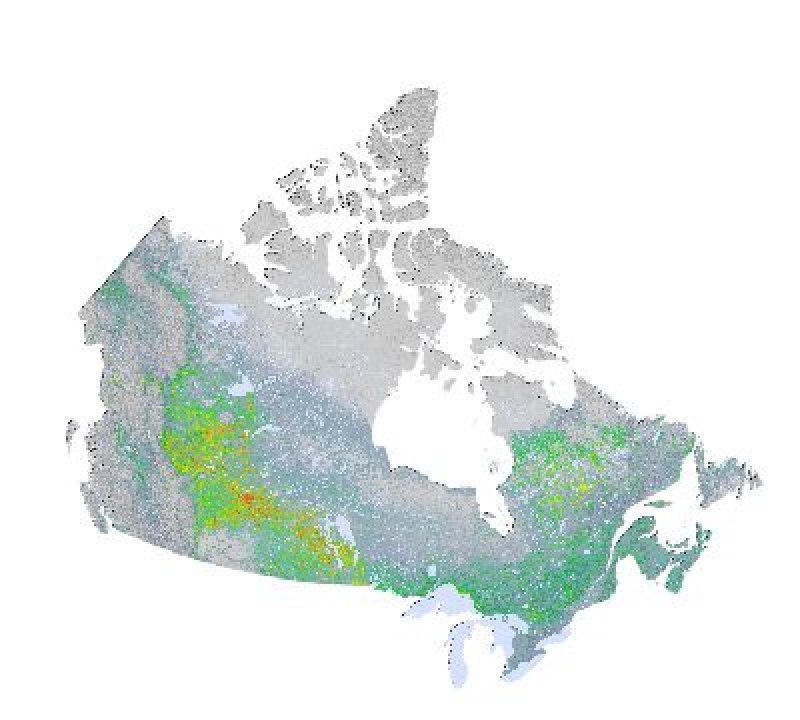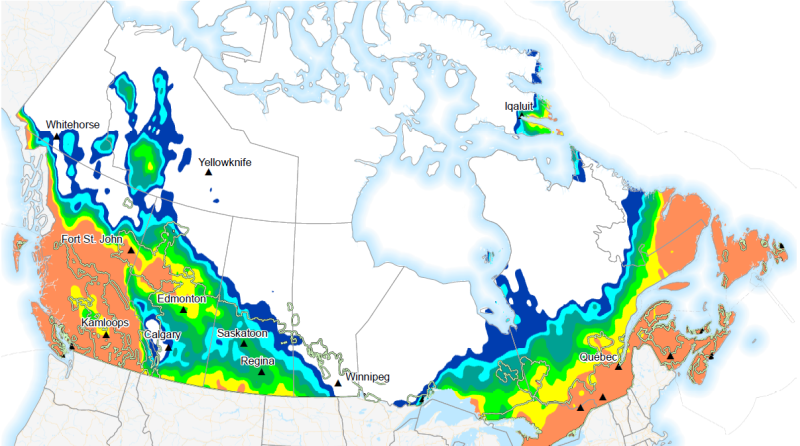GeoTIF
Type of resources
Available actions
Topics
Keywords
Contact for the resource
Provided by
Formats
Representation types
Update frequencies
status
Scale
Resolution
-

The wetland year count data included in this product is national in scope (entire forested ecosystem) and represents a wall to wall wetland characterization for 1984-2016 (Wulder et al. 2018). This product was generated using both annual gap free composite reflectance images and annual forest change maps following the Virtual Land Cover Engine (VLCE) process (see Hermosilla et al. 2018), over the 650 million ha forested ecosystems of Canada. Elements of the VLCE classification approach are inclusion of disturbance information in the processes as well as ensuring class transitions over time are logical. Further, a Hidden Markov Model is implemented to assess individual year class likelihoods to reduce variability and possible noise in year-on-year class assignments (for instances when class likelihoods are similar). The values can range from 0 to 33 denoting the number of years between 1984 and 2016 that a pixel was classified as wetland or wetland-treed in the VLCE data cube. For an overview on the data, image processing, and time series change detection methods applied, as well as information on independent accuracy assessment of the data, see Hermosilla et al. (2016; http://www.tandfonline.com/doi/full/10.1080/17538947.2016.1187673). A detailed description of the VLCE process and the subsequently generated land cover product, including an accuracy assessment, please see Hermosilla et al. (2018). The focused wetland analyses can be found described in Wulder et al (2018). Geographic extent: Canada's forested ecosystems (~ 650 Mha) Time period: 1985–2011
-

The probability of effective growing season degree days above 100 for cool season crops. This condition must be maintained for at least 5 consecutive days in order for EGDD to be accumulated (egdd_cool_100prob). Week 1 and week 2 forecasted probability is available daily from April 1 to October 31. Week 3 and week 4 forecasted probability is available weekly (Thursday) from April 1 to October 31. Cumulative heat-energy satisfies the essential requirement of field crop growth and development towards a high yield and good quality of agricultural crop products. Agriculture and Agri-Food Canada (AAFC) and Environment and Climate Change Canada (ECCC) have together developed a suite of extreme agrometeorological indices based on four main categories of weather factors: temperature, precipitation, heat, and wind. The extreme weather indices are intended as short-term prediction tools and generated using ECCC’s medium range forecasts to create a weekly index product on a daily and weekly basis.
-

Fish Habitat Assessment Output: 12 of 16 Average Water Level (75.0m ASL) - Nursery Habitat - Low Vegetation Association Species (All Temperature Windows) Habitat suitability was assessed for the Bay of Quinte Area of Concern, at a 3 m grid resolution, using the Habitat Ecosystem Assessment Tool (HEAT), temperature algorithms, vegetation models, and water level input. Habitat classifications were based on three variables: depth (elevation), vegetation, and substrate; and modified by temperature suitabilities. The final suitability maps were based on documented habitat and temperature associations for the fish in the area. Different life stages (spawning requirements, nursery habitat, adult habitat) were modeled for the years of 1972-2011. Suitability values were scaled from 0 (not suitable) to 1 (highly suitable) and converted to suitability classes of very low, low, medium, and high. The final maps for each guild – life stage combination are maximum suitability values from the 39-year period modelled.
-

Fish Habitat Assessment Output: 10 of 16 Average Water Level (75.0m ASL) - Spawning Habitat - Low Vegetation Association Species (All Temperature Windows) Habitat suitability was assessed for the Bay of Quinte Area of Concern, at a 3 m grid resolution, using the Habitat Ecosystem Assessment Tool (HEAT), temperature algorithms, vegetation models, and water level input. Habitat classifications were based on three variables: depth (elevation), vegetation, and substrate; and modified by temperature suitabilities. The final suitability maps were based on documented habitat and temperature associations for the fish in the area. Different life stages (spawning requirements, nursery habitat, adult habitat) were modeled for the years of 1972-2011. Suitability values were scaled from 0 (not suitable) to 1 (highly suitable) and converted to suitability classes of very low, low, medium, and high. The final maps for each guild – life stage combination are maximum suitability values from the 39-year period modelled.
-

Fish Habitat Assessment Output: 11 of 16 Average Water Level (75.0m ASL) - Nursery Habitat - High Vegetation Association Species (All Temperature Windows) Habitat suitability was assessed for the Bay of Quinte Area of Concern, at a 3 m grid resolution, using the Habitat Ecosystem Assessment Tool (HEAT), temperature algorithms, vegetation models, and water level input. Habitat classifications were based on three variables: depth (elevation), vegetation, and substrate; and modified by temperature suitabilities. The final suitability maps were based on documented habitat and temperature associations for the fish in the area. Different life stages (spawning requirements, nursery habitat, adult habitat) were modeled for the years of 1972-2011. Suitability values were scaled from 0 (not suitable) to 1 (highly suitable) and converted to suitability classes of very low, low, medium, and high. The final maps for each guild – life stage combination are maximum suitability values from the 39-year period modelled.
-

Canada's National Forest Inventory (NFI) sampling program is designed to support reporting on forests at the national scale. On the other hand, continuous maps of forest attributes are required to support strategic analyses of regional policy and management issues. We have therefore produced maps covering 4.03 × 106 km2 of inventoried forest area for the 2001 base year using standardised observations from the NFI photo plots (PP) as reference data. We used the k nearest neighbours (kNN) method with 26 geospatial data layers including MODIS spectral data and climatic and topographic variables to produce maps of 127 forest attributes at a 250 × 250 m resolution. The stand-level attributes include land cover, structure, and tree species relative abundance. In this article, we report only on total live aboveground tree biomass, with all other attributes covered in the supplementary data (http://nrcresearchpress.com/doi/suppl/10.1139/cjfr-2013-0401). In general, deviations in predicted pixel-level values from those in a PP validation set are greater in mountainous regions and in areas with either low biomass or sparse PP sampling. Predicted pixel-level values are overestimated at small observed values and underestimated at large ones. Accuracy measures are improved through the spatial aggregation of pixels to 1 km2 and beyond. Overall, these new products provide unique baseline information for strategic-level analyses of forests (https://nfi.nfis.org) Collection: - **[Canada's National Forest Inventory (NFI) 2006](https://open.canada.ca/data/en/dataset/e2fadaeb-3106-4111-9d1c-f9791d83fbf4)**
-

Probability of daily precipitation above 25mm over the forecast period (p1d25_prob). Week 1 and week 2 forecasted probability is available daily from September 1 to August 31. Week 3 and week 4 forecasted probability is available weekly (Thursday) from September 1 to August 31. Units: mm Precipitation (moisture availability) establishes the economic yield potential and product quality of field crops. Both dry and wet precipitation extremes have the ability to inhibit proper crop growth. The greatest daily precipitation index covers the risk of excessive precipitation in the short term, while the other indices pertain to longer term moisture availability. Agriculture and Agri-Food Canada (AAFC) and Environment and Climate Change Canada (ECCC) have together developed a suite of extreme agrometeorological indices based on four main categories of weather factors: temperature, precipitation, heat, and wind. The extreme weather indices are intended as short-term prediction tools and generated using ECCC’s medium range forecasts to create a weekly index product on a daily and weekly basis.
-

Canada Harmonized Agriculture Forest Land Cover 2015 The harmonized land cover (HLC) map is produced from Agriculture and Agri-Food Canada (AAFC) and Canadian Forest Service (CFS) data. The HLC product is exhaustive of all area from the northern edge of Canada’s forested ecosystems to the southern border. The land cover is following Intergovernmental Panel on Climate Change (IPCC) categories, represents the year 2015, and is at 30-m spatial resolution. This harmonized land cover map combines two sector-driven land cover products: the Virtual Land Cover Engine or VLCE from the CFS (Hermosilla et al., 2018), and AAFC's Annual Crop Inventory or ACI (Agriculture and Agri-Food Canada, 2018). The harmonization process was conducted using a Latent Dirichlet Allocation (LDA) model. The LDA model used regionalized class co-occurrences from multiple maps to generate a harmonized class label for each pixel by statistically characterizing land attributes from the class co-occurrences, using the information provided by the error matrices and semantic affinity scores. For a complete overview on the data, methods applied, and information on independent accuracy assessment, see Li et al. (2020). When using this data, please cite as: Li, Z., White, J.C., Wulder, M.A., Hermosilla, T., Davidson, A.M., Comber, A.J., 2020. Land cover harmonization using Latent Dirichlet Allocation. International Journal of Geographical Information Science. DOI: https://doi.org/10.1080/13658816.2020.1796131 (Open access) ( Li et al. 2020). For additional resources on the data used and methods applied, please see: Hermosilla, T., Wulder, M.A., White, J.C., Coops, N.C., Hobart, G.W., 2018. Disturbance-informed annual land cover classification maps of Canada’s forested ecosystems for a 29-year Landsat time series. Canadia Journal of Remote Sensing 44(1), 67-87. https://doi.org/10.1080/07038992.2018.1437719 (Open access) ( Hermosilla et al. 2018). Agriculture and Agri-Food Canada, 2018. Annual Crop Inventory [WWW Document]. URL https://open.canada.ca/data/en/dataset/ba2645d5-4458-414d-b196-6303ac06c1c9. ( AAFC, 2018. Annual Crop Inventory ).
-

The probability (likelihood) of ice freeze days, the number of days in the forecast period with a minimum temperature below the frost temperature, -30°C for woody crops over the dormant period (ifd_wood_dorm_prob). Week 1 and week 2 forecasted probability is available daily from November 1 to March 31. Week 3 and week 4 forecasted probability is available weekly (Thursday) from November 1 to March 31. Over-wintering crops are biennial and perennial field crops such as herbaceous plants (strawberry, alfalfa, timothy, and many other forage crops) and woody fruit trees (apple, pear, peach, cherry, plum, apricot, chestnut, pecan, grape, etc.). These crops normally grow and develop in the growing season and become dormant in the non-growing season. However, extreme weather and climate events such as cold waves in the growing season and ice freezing events during the winter are a major constraint for their success of production and survival in Canada. The winter survival of these plants depends largely on agrometeorological conditions from late autumn to early spring, especially ice-freezing damage during the winter season. The optimum temperature for such crops is 25°C. Agriculture and Agri-Food Canada (AAFC) and Environment and Climate Change Canada (ECCC) have together developed a suite of extreme agrometeorological indices based on four main categories of weather factors: temperature, precipitation, heat, and wind. The extreme weather indices are intended as short-term prediction tools and generated using ECCC’s medium range forecasts to create a weekly index product on a daily basis.
-

The Probability (likelihood) of cool wave days for cool season/overwintering crops occurring Cool Wave Days are the number of days in the forecast period with a minimum temperature below the cardinal minimum temperature, the lowest temperature at which crop growth will begin (dcw_cool_prob). This temperature is 5°C for cool season crops. Week 1 and week 2 forecasted probability is available daily from April 1 to October 31. Week 3 and week 4 forecasted probability is available weekly (Thursday) from April 1 to October 31. Cool season crops require a relatively low temperature condition. Typical examples include wheat, barley, canola, oat, rye, pea, and potato. They normally grow in late spring and summer, and mature between the end of summer and early fall in the southern agricultural areas of Canada. The optimum temperature for such crops is 25°C. Agriculture and Agri-Food Canada (AAFC) and Environment and Climate Change Canada (ECCC) have together developed a suite of extreme agrometeorological indices based on four main categories of weather factors: temperature, precipitation, heat, and wind. The extreme weather indices are intended as short-term prediction tools and generated using ECCC’s medium range forecasts to create a weekly index product on a daily and weekly basis.
 Arctic SDI catalogue
Arctic SDI catalogue